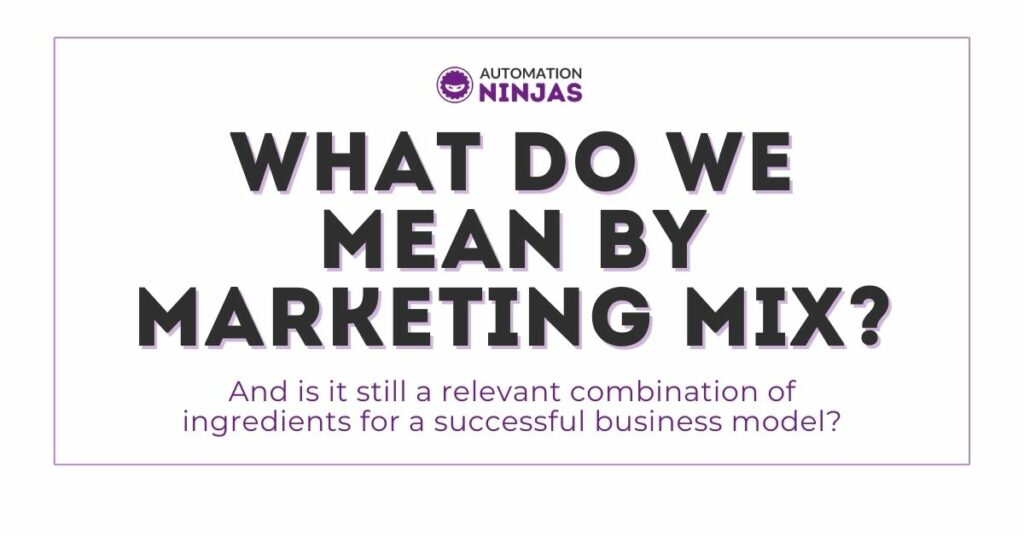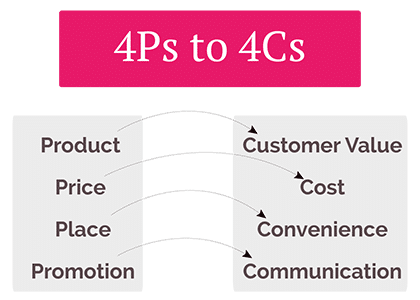Author: Ashton Oldham
Hey there, I'm Ashton, the Content Ninja with a penchant for creativity! I'm all about crafting killer customer-focused content and sprinkling it with that special sauce that makes brands pop. Teaching, strategising, organising (people and projects), and spicing up collaborations? That's my jam!
First, let’s understand where ‘Marketing Mix’ comes from
The marketing mix is arguably one of the most famous terms in marketing. If it were an actor, it would be up there with the A-listers. Ok, maybe not Meryl Streep, or Dwayne ‘The Rock’ Johnson… It’s more of a Nic Cage, or Bill Murray.
(Please don't shoot, I'm more of a MurCage person myself!)
Basically, it was BIG in its day. Everyone put it at the heart of their marketing strategy.
Nowadays, it’s still about, reminding us marketers to think back to the simplicity of the concept. It still makes an appearance here and there in the realm of marketing, but as things have evolved, the term is referred to a little less.
So, where did it come from?
In the 1940s Harvard Business School Professor, Neil Borden coined the term ‘Marketing Mix’. Then, in 1964, he published an article titled “The Concept of the Marketing Mix”, from which the concept blew up in popularity.
The Marketing mix is essentially a business recipe for success. It is made up of a selection of ‘ingredients’ - now known as The 4 Ps - a suggestion cooked up by E. Jerome McCarthy.
The 4 Ps of the Marketing Mix (Product, Price, Place, Promotion)
Product
Yep, pretty obvious… this is all about the product offering. What it is, what it does and how it works.
The important thing about the product is that it does what consumers want it for. It should meet their expectations. (Or better yet, exceed them.)
To nail this, it’s crucial to understand consumers’ problems the product solves for. If your business doesn’t know this, then it’s likely you’ll struggle to sell the product.
So, this ‘P’ is about getting clear on the features, the benefits, and the USPs of said product. And, why consumers will want it in the first place.
Products also have a lifecycle. It’s broken into 4 stages - introduction, growth, maturity, and decline.
Your businesses should be clear on the lifecycle and plan marketing strategies for each stage. This may be to increase advertising, alter pricing, move into different markets, or redesign the product itself.
The iPhone has been around for donkey’s years. It’s (at the time of writing) almost 15 years old. Imagine using a mobile phone that you’ve had for at least 15 years! It seems pretty ridiculous, right?
Apologies to anyone who is still donning a Nokia 3310 - to be fair, one of the best mobiles ever invented!

Let me get to the point. Apple has simply redesigned the iPhone time and time again. The base concept, the problems it solves are still there. It’s just had continuous upgrades and additions to solve new problems.
Price
You’ve got your product, now you need to decide how much to put it on the market for. What’s it worth?
This is where understanding your customers’ challenges, wants and needs is again very important. What will they be willing to pay for a product?
It must be good value for money. That doesn’t necessarily mean cheap - many customers will be willing to pay more for something that undoubtedly improves their life.
We’re talking about perceived value over the actual price tag attached.
Understanding the value to a person, by looking at what problems it solves, will help to price the product accordingly.
You must also be clear on the market. What is your product competing against? How saturated is it?
Place
It’s distribution time. Where oh where should your product be located for the market to snap it up?
Well, it all depends on your ideal customer. Where do they tend to shop? Do they hang out online or, shop in-store?
Is your product going to stand out in these places, how do you ensure it does?
Launching your product via the wrong channels, in the wrong place, to the wrong people is avoidable. Do your research and get super clear on location, location, location.
And, don’t just expect customers to come to you. I’m sure you’re product is great, but you need to get it out there. Go to them.
Promotion
Time to shout about your product with all its bells and whistles.
You’ve got a wide variety of communication options to choose from - advertising, social media, outbound marketing, inbound marketing, promotions, partnerships, etc.
Find the right avenue/s for your product promotion, but, before you go firing on all cylinders, get your messaging bang on.
Bad messaging in the right place can really damage your brand. And, it’s tough to reverse.
In my past, I experienced a situation where all the foundational work was rushed and fine-tuning hardly acknowledged because a business was so determined to meet a Go To Market deadline.
What happened? It flopped. It was a strategic mess and customers (unsurprisingly) were savvy enough to notice all the holes. Trust me, it takes far more effort to rectify a mistake like that than hold fire and get it nailed in the first place.

Humans - they don’t forget!
The 7 Ps of the Marketing Mix (All the above + Process, People and Physical Evidence)
Nearing the end of the 70s, Marketers believed ‘the marketing mix’ needed updating. There were a few key things that needed to be considered as standalone priorities of a great marketing strategy.
Also, if you are from the service industry, you may have felt the 4 Ps more weighted to eCommerce. And, perhaps yes it was, initially. The extra three Ps, however, are definitely service-related.
Let’s take a look...
Process
Now, ‘process’ can be a widely cast net. It should encompass all areas of the business, from product development to customer service & support…
But, in marketing terms - as that’s the focus of this blog - process relates to your customer journey and everything behind the scenes to provide an incredible experience.
You need to be very clear on each stage of the customer journey. And, though it doesn’t really reflect the naming convention, the journey starts way before a person/business even becomes a customer.
Once you’ve designed your ideal journey (the #1 process), it makes it far easier to establish the background processes.
If you want to get clued up on customer journey mapping, have a read of our blog.
People
In the 7 Ps, ‘people’ is all about your business. Those brilliant humans that make up a company.
Every person is important, it’s not all about your sales and marketing team - they are just the front end. And, though crucial to business success, it’s important to remember everyone plays a key role.
Your entire faculty should believe in what you do and why. Your values, goals, and motivations should be shared across the board. The reasons for providing the product/service you do should be instilled.
Hiring and training the right kind of people goes without saying really. It’s also important to empower them in their areas of expertise, whether they are marketers, sales, support staff, programmers, UX designers, quality control - you name it!
Often what makes a company stand out from its competitors, is the team that delivers the products and services.
I also just want to drop something else in here. Never forget about the people that make up a market.
They are the reason for your business existing in the first place. Keep your marketing strategy aligned with their wants, needs, interests, etc. Prepare to evolve with them and put them at the heart of everything you do. Trust me, they will notice!
Related content:
Physical Evidence
I find this a weirdly named P... I get it, but it’s a little bit CSI - and yes, I probably do watch far too much true crime!
Physical evidence refers to obvious things like branding, product design, and packaging. However, it goes deeper than that.
It’s anything tangible presented to the market. The company (people) itself, their ‘uniform’, what the building/office/shop looks like, the plates you use in your restaurant, your website, brochures, social media, emails… everything impacts the customers’ thoughts and feelings about your business.
This also became quite an important P in the service industries, in the way that delivering the service is evidence in itself.
If the service doesn’t match up to the promise made to the customer, this is bad physical evidence - as poor as providing a faulty product.

Don’t get yourself in this situation… it’s heartbreaking.
The 7 Ps work and interact with each other. They provide businesses with a key understanding of what consumers want from them, how their product or service meets or fails to meet those needs, how their product or service is perceived in the world, how they stand out from their competitors, and how they interact with their customers.
You can see why it’s still a popular model to base business and marketing strategies on!
What are the 4 Cs and why do we (Ninjas) prefer them?
Developed by Robert F. Lauterborn in the 1990s, the 4 Cs is a spinoff of the 4 Ps. It doesn’t by any means make the Ps redundant, we just like the model a little better. Let me explain why…
The 4 Ps are often considered more business-oriented, and the 4 Cs more customer-oriented. If you know anything about us, you know that we are all about customer-first marketing.
Using the 4 Cs marketing model diverts businesses away from the traditional mass marketing approach. Instead, it takes a more niche and targeted direction.
With pretty much every marketing being saturated with the same/similar solution, mass appeal is a tough cookie to crack.
It’s also super demanding on business resources. So, unless you are planning on being a big player - like Apple, Nike, Microsoft, or Amazon - the targeted approach will better suit you.
Using the Marketing Mix to bolster your strategy
First off, don’t get overwhelmed with the amount of Ps on your plate.
Start by reviewing where you are right now. Create a basic table, headed by the 7 Ps, and start to fill it with what you are doing in each section right now.
Then, do some research. Identify any gaps, areas that seem misaligned to your goals, and those of your ideal customer. Add those ideas to your table in a different colour, strike out the things that need to change or be completely removed.
You’ll get a much clearer picture of where you are going right, and wrong. Then you can start to focus on one section at a time. Which P needs the most work? Which P is a quick win?
Block out some project time, create some processes to keep you on track, and go for it!

Join the Marketing Brainbox to stay in the loop with the latest marketing news and exclusive content
If you’re unsure what you need, please get in touch. We can have chat about your challenges and help you find clarity to take the next step!



